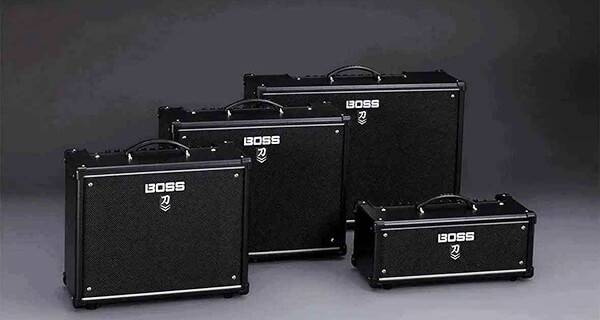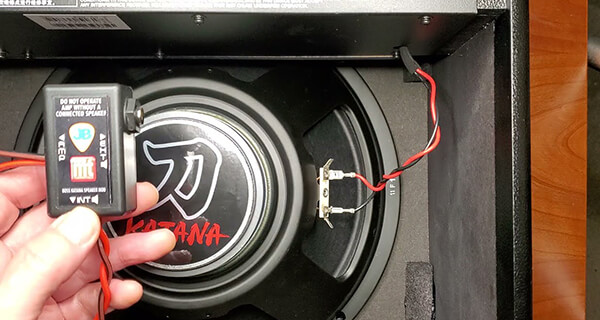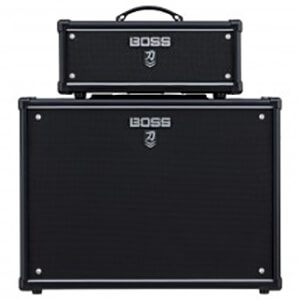Boss Katana 50 Vs 100 [Difference & Which is Better Amp]
For any guitarist, the quest for the perfect amplifier is a never-ending journey. In this pursuit, the Boss Katana series has emerged as a shining beacon of tonal excellence, offering a tantalizing blend of versatility, power, and affordability. Two models that often find themselves in the spotlight are the Boss Katana 50 and the Boss Katana 100 amplifiers.
As you stand at the crossroads of amplifier selection, it’s crucial to dissect these sonic warriors comprehensively. Both amplifiers bear the revered Katana name, yet they harbor distinct attributes that cater to different musical battlegrounds.

In this epic tonal showdown, we’ll explore the intricacies of the Boss Katana 50 vs 100, uncovering their strengths, weaknesses, and the ultimate question: which amplifier reigns supreme for your unique musical odyssey? Strap in, as we embark on a journey to unearth the secrets of these formidable amplifiers.
# Table of Contents =>
- 1 Differences Between the Boss Katana 50 Vs 100 Amp:
Comparison Table:
| Features – | Boss Katana 50 | Boss Katana 100 |
|---|---|---|
| Power Output | 50 watts | 100 watts |
| Speaker Configuration | 12-inch custom speaker | 12-inch custom speaker |
| Channels | 2 (Clean and Lead) | 2 (Clean and Lead) |
| Built-in Effects | Yes | Yes |
| Number of Effects | 5 | 5 |
| EQ Controls | Bass, Middle, Treble | Bass, Middle, Treble |
| Tone Settings | 5 onboard amp types | 5 onboard amp types |
| Effects Loop | Yes | Yes |
| Power Scaling | 0.5, 25, and 50 watts | 0.5, 50, and 100 watts |
| USB Recording | Yes | Yes |
| Footswitch Compatibility | GA-FC Foot Controller | GA-FC Foot Controller |
| Weight | Approximately 26 lbs | Approximately 34 lbs |
| Dimensions (H x W x D) | 15.125″ x 18.625″ x 9.625″ | 19.875″ x 19.625″ x 9.6875″ |
| Price Range | (Moderate) | (Moderately High) |
A) Boss Katana 50: Specification –
- Power Output: 50 watts
- Speaker Configuration: 12-inch custom speaker
- Amp Models: Five unique amp characters with variations
- Built-In Effects: Delay, reverb, modulation, and more
- Power Scaling: Yes, down to 0.5 watts
- Tone Shaping: Three-band EQ and presence control
- Weight: Approximately 25 pounds (11.3 kg)
Pros of Boss Katana 50:
1. Portability: The Katana 50 is compact and lightweight, making it highly portable for practice sessions and smaller gigs.
2. Power Scaling: The 0.5-watt power scaling feature is perfect for quiet home practice without compromising on tone.
3. Customizable Effects: The amp offers a variety of built-in effects that can be tailored & combined to create your signature sound.
4. User-Friendly: The control panel is intuitive & easy to navigate. Which it suitable for both beginners and experienced guitarists.
Cons of Boss Katana 50:
1. Wattage Limitation: The 50-watt power may not be sufficient for larger venues and gigs.
2. Limited Clean Headroom: At higher volumes, the amp may reach its saturation point earlier compared to the Katana 100.
B) Boss Katana 100: Specification
- Power Output: 100 watts
- Speaker Configuration: 12-inch custom speaker
- Amp Models: Five unique amp characters with variations
- Built-In Effects: Delay, reverb, modulation, and more
- Power Scaling: Variable power control
- Tone Shaping: Three-band EQ and presence control
- Weight: Approximately 32.6 pounds (14.8 kg)
Pros of Boss Katana 100:
1. Versatile Power: With 100 watts of power, the Katana 100 is suitable for larger venues and gigs, offering ample volume.
2. Clean Headroom: Higher wattage provides more clean headroom, making it ideal for pristine, loud cleans at high volumes.
3. Versatile Usage: The 100-watt output is versatile for various musical situations and playing styles.
4. Customizable Effects: Like the Katana 50, it features a range of built-in effects that can be tweaked to achieve your desired sound.
Cons of Boss Katana 100:
1. Size and Weight: It’s slightly heavier and bulkier than the Katana 50, which may affect portability.
2. Price: The Katana 100 often comes at a higher price point due to its increased wattage and features.
Differences Between the Boss Katana 50 Vs 100 Amp:
Now that we’ve explored the features of both amplifiers, let’s delve into the key differences that set the Katana 50 and Katana 100 apart. These distinctions can help you determine which amplifier aligns better with your musical aspirations.
1. Power Output –
This discrepancy in power output has several implications:
a) Venue Size:

The Katana 50 is ideal for smaller venues, practice sessions, and home use. It provides sufficient volume for most intimate performances. In contrast, the Katana 100 is better suited for larger venues and gigs, where the additional wattage ensures your guitar cuts through the mix.
b) Volume Headroom:
Higher wattage amplifiers like the Katana 100 tend to have more clean headroom, meaning they can stay clean at louder volumes. This can be advantageous if you require a pristine, clean tone at high volumes.
c) Tone Saturation:
The Katana 50 may reach its saturation point (where the tone starts to distort) at lower volumes compared to the Katana 100. If you prefer a heavily saturated tone, the Katana 100 may offer more headroom before reaching that point.
2. Built-In Effects –
The Katana 50 boasts an impressive selection of onboard effects, encompassing features such as delay, reverb, modulation, and more. These effects are entirely customizable, allowing you to blend and configure them to craft your distinct and personalized sonic signature. The amp also features a dedicated effects loop, enabling you to integrate external pedals and processors into your setup seamlessly.
The Katana 100 comes equipped with the same impressive built-in effects as the Katana 50. These effects can be customized and combined to create your preferred sound. Additionally, the amp includes an effects loop for integrating external pedals and processors into your signal chain.
3. Speaker Configuration –

Similar to the Katana 50, the Katana 100 features a 12-inch custom speaker. This carefully selected speaker contributes to the amp’s overall sound quality, providing clarity and projection on stage.
This amplifier features a 12-inch custom speaker designed to reproduce your guitar’s sound faithfully. The speaker’s size contributes to the overall tone and projection of the amp, and the Katana 50’s speaker is carefully chosen to provide a balanced and clear sound.
4. Weight and Portability –

The Katana 50’s lower wattage also results in a lighter and more portable design compared to the Katana 100. If you frequently travel or gig in different locations, the Katana 50’s compact size and reduced weight make it a more convenient choice.
5. Power Scaling –
The Katana 50 has a unique power scaling feature that allows you to reduce its wattage to 0.5 watts for quiet practice. This is a significant advantage if you need to maintain your tone at lower volumes, making it an excellent choice for home practice and recording. The Katana 100, on the other hand, offers variable power control but lacks the 0.5-watt option.
6. Price –
The Katana 50 is typically more affordable than its 100-watt counterpart. You can often find it in the range of $200 to $300 USD. Prices may fluctuate based on the condition & any bundled accessories or promotions.
The Katana 100, being a higher-wattage model with more features, tends to be priced higher than the Katana 50. It usually falls in the range of $300 to $500 USD, again depending on factors such as new or used condition and any additional features or bundles.
Short Features of Boss Katana 100 mk1 & mk2:
The Boss Katana 100 comes in two versions: the Mk1 and Mk2.
a) Boss Katana 100 Mk1:
- 100 watts of power, suitable for various settings.
- 3-band EQ and built-in Boss effects.
- Multiple amp models.
- Compact and portable.
b) Boss Katana 100 Mk2:
- An updated version with more features.
- 100 watts of power.
- Additional amp models and effects.
- Enhanced tone-shaping options.
- Compact and portable design.
Both are versatile and well-regarded amps, with the Mk2 offering more features and flexibility for tone shaping and effects. Your choice depends on your needs and preferences.
Short Features of Boss Katana 50 mk1 & mk2:
The Boss Katana 50 Mk1 and Mk2 are two versions of the popular Katana series guitar amplifiers. Here’s a brief overview of each:
a) Boss Katana 50 Mk1:
- Offers 50 watts of power, suitable for practice and small gigs.
- Features a 3-band EQ and built-in Boss effects, including modulation, delay, and reverb.
- Provides a variety of amp models to achieve different tones.
- Compact and portable design.
- Well-regarded for its affordability and tone quality in a smaller package.
b) Boss Katana 50 Mk2:
- An updated version of the Katana 50.
- Maintains 50 watts of power.
- Offers additional amp models and built-in effects compared to the Mk1.
- Enhanced tone-shaping options for more precise sound customization.
- Compact and portable design, suitable for practice and small performances.
- Released as an improved version with more features and flexibility.
I) Consider the Katana 50 if:
- You primarily play at home or in smaller venues.
- Portability is a crucial factor for you, and you need a lightweight amplifier.
- You appreciate the 0.5-watt power scaling feature for quiet practice.
- Your budget is limited, as the Katana 50 is typically more budget-friendly.
II) Consider the Katana 100 if:
- You regularly perform in larger venues and require a higher wattage for ample volume.
- Clean headroom is essential for your playing style.
- You want the versatility of a 100-watt amplifier for various musical situations.
- You can accommodate a slightly larger and heavier amplifier in your setup.
Choosing the Right Katana Amplifier:
Katana 50: Ideal for practice, small venues, and those on a budget, with a focus on portability and home use.
Katana 100: Suited for larger venues, gigging musicians, and those who prioritize higher wattage and clean headroom.
In conclusion, the choice between the Boss Katana 50 vs 100 depends on your specific requirements as a guitarist. Both amplifiers offer excellent tone, versatility, and built-in effects, but their differences in wattage and portability make each better suited for particular scenarios. Consider your playing style, venue size, and budget when making your decision to ensure you get the amplifier that best suits your musical needs.
Read also: Positive Grid Spark Vs Boss Katana
Last Updated on October 12, 2023 by Perry Garner


